The Restoration Potential of the Grasslands on the Tibetan Plateau
Abstract
:1. Introduction
2. Materials and Methods
2.1. Overview of the Study Area
2.2. Data Sources and Preprocessing
2.2.1. Meteorological Data
2.2.2. Total Solar Radiation (SOL) Data
2.2.3. Moderate-Resolution Imaging Spectroradiometer (MODIS) Data
2.2.4. Grassland Type Data and Climate Zone Data
2.3. ANPP
2.4. PNPP
2.4.1. TM Model
2.4.2. PSH
2.4.3. Chikugo Model
2.5. Restoration Potential (R)
2.6. Trend Analysis
3. Results
3.1. Comparison of Three Types of R
3.2. The Trends of R
3.3. R Analysis Based on the Type of Grassland
3.4. Analysis of Grassland R by Altitude
3.5. Analysis of Grassland R by Climate Zone
4. Discussion
4.1. Research Methods
4.2. Contribution to Carbon Sequestration
4.3. Which Grasslands on the TP Are Worthy of Restorative Efforts?
4.4. Limitations
5. Conclusions
Author Contributions
Funding
Institutional Review Board Statement
Informed Consent Statement
Data Availability Statement
Conflicts of Interest
References
- Liu, Y.; Zhang, Z.; Tong, L.; Khalifa, M.; Wang, Q.; Gang, C.; Wang, Z.; Li, J.; Sun, Z. Assessing the effects of climate variation and human activities on grassland degradation and restoration across the globe. Ecol. Indic. 2019, 106, 105504. [Google Scholar] [CrossRef]
- Wang, Y.; Ren, Z.; Ma, P.; Wang, Z.; Niu, D.; Fu, H.; Elser, J.J. Effects of grassland degradation on ecological stoichiometry of soil ecosystems on the Qinghai-Tibet Plateau. Sci. Total Environ. 2020, 722, 137910. [Google Scholar] [CrossRef]
- Sun, J.; Fu, B.; Zhao, W.; Liu, S.; Liu, G.; Zhou, H.; Shao, X.; Chen, Y.; Zhang, Y.; Deng, Y. Optimizing grazing exclusion practices to achieve Goal 15 of the sustainable development goals in the Tibetan Plateau. Sci. Bull. 2021, 66, 1493–1496. [Google Scholar] [CrossRef]
- He, L.; Bin, J.; Deng, D.; Yan, W.; Chen, D. Review on progress in vegetation close-to-nature recovery. J. Sichuan For. Sci. Technol. 2017, 38, 18–21. [Google Scholar]
- He, J.; Bu, H.; Hu, X.; Feng, Y.; Li, S.; Zhu, J.; Liu, G.; Wang, Y.; Nan, Z. Close-to-nature restoration of degraded alpine grasslands: Theoretical basis and technical approach. Chin. Sci. Bull. 2020, 65, 3898–3908. (In Chinese) [Google Scholar] [CrossRef]
- Strassburg, B.B.; Iribarrem, A.; Beyer, H.L.; Cordeiro, C.L.; Crouzeilles, R.; Jakovac, C.C.; Junqueira, A.B.; Lacerda, E.; Latawiec, A.E.; Balmford, A.; et al. Global priority areas for ecosystem restoration. Nature 2020, 586, 724–729. [Google Scholar] [CrossRef] [PubMed]
- Li, Q.; Gao, S.; Zhang, C.; Wang, R.; Zhou, N.; Li, J.; Guo, Z.; Chang, C. Assessment of the Impacts of Climate Change and Human Activities on the Dynamic Grassland Change in Inner Mongolia. Geogr. Geo-Inf. Sci. 2019, 35, 99–104. [Google Scholar]
- Venter, Z.S.; Scott, S.L.; Desmet, P.G.; Hoffman, M.T. Application of Landsat-derived vegetation trends over South Africa: Potential for monitoring land degradation and restoration. Ecol. Indic. 2020, 113, 106206. [Google Scholar] [CrossRef]
- Gao, H.; Pang, G.; Li, Z.; Cheng, S. Evaluating the potential of vegetation restoration in the Loess Plateau. Acta Geogr. Sin. 2017, 72, 863–874. [Google Scholar]
- Zhao, G.; Mu, X.; Tian, P.; Gao, P.; Sun, W.; Xu, W. Prediction of Vegetation Variation and Vegetation Restoration Potential in the Loess Plateau. J. Soil Water Conserv. 2021, 35, 205–212. [Google Scholar]
- Li, H.; Qin, W.; Zhang, T.; Shen, W. Comprehensive evaluation model for revegetation potentiality on moving sandy land in alpine valley of Tibet, China. Trans. Chin. Soc. Agric. Eng. 2015, 31, 220–228. [Google Scholar]
- Emamian, A.; Rashki, A.; Kaskaoutis, D.G.; Gholami, A.; Opp, C.; Middleton, N. Assessing vegetation restoration potential under different land uses and climatic classes in northeast Iran. Ecol. Indic. 2021, 122, 107325. [Google Scholar] [CrossRef]
- De, M.; Riopel, J.A.; Cihacek, L.J.; Lawrinenko, M.; Baldwin-Kordick, R.; Hall, S.J.; McDaniel, M.D. Soil health recovery after grassland reestablishment on cropland: The effects of time and topographic position. Soil Sci. Soc. Am. J. 2020, 84, 568–586. [Google Scholar] [CrossRef]
- Gao, W.; Lei, X.; Fu, L. Impacts of climate change on the potential forest productivity based on a climate-driven biophysical model in northeastern China. J. For. Res. 2020, 31, 2273–2286. [Google Scholar] [CrossRef] [Green Version]
- Pan, J.; Xu, B. Modeling spatial distribution of potential vegetation NPP in China. Chin. J. Ecol. 2020, 39, 1001–1012. [Google Scholar]
- Li, C.; Fan, Y.; Cao, H.; Han, H. Impact of human activities on net primary productivity based on the CASA model: A case study of the Shiyang River Basin. Arid. Land Geogr. 2018, 41, 142–151. [Google Scholar]
- Lv, Z.; Li, W.; Huang, X.; Zhang, Z. Larix principis-rupprechtii Growth Suitability Based on Potential NPP under Climate Change Scenarios in Hebei Province. Sci. Silvae Sin. 2019, 55, 37–44. [Google Scholar]
- Ren, Z.; Zhu, H.; Shi, H.; Liu, X. Spatiotemporal-Distribution Pattern Variation of Net Primary Productivity in Potential Natural Vegetation and Its Response to Climate and Topography in China. Acta Agrestia Sin. 2017, 25, 474–485. [Google Scholar]
- Li, H.; Hong, Y.; Deng, G.; Wu, R.; Zhang, H.; Zhao, J.; Guo, X. Impact of climate change and human activities on net primary productivity of grasslands in Inner Mongolia, China during 1982–2015. Chin. J. Appl. Ecol. 2021, 32, 415–424. [Google Scholar]
- Sun, Z.; Wu, J.; Liu, F.; Shao, T.; Liu, X.; Chen, Y.; Long, X.; Rengel, Z. Quantitatively assessing the effects of climate change and human activities on ecosystem degradation and restoration in southwest China. Rangel. J. 2019, 41, 335–344. [Google Scholar] [CrossRef]
- Zhang, C.; Wang, X.; Li, J.; Hua, T. Roles of climate changes and human interventions in land degradation: A case study by net primary productivity analysis in China’s Shiyanghe Basin. Environ. Earth Sci. 2011, 64, 2183–2193. [Google Scholar] [CrossRef]
- Jahelnabi, A.E.; Wu, W.; Boloorani, A.D.; Salem, H.M.; Nazeer, M.; Fadoul, S.M.; Khan, M.S. Assessment the Influence of Climate and Human Activities in Vegetation Degradation using GIS and Remote Sensing Techniques. Contemp. Probl. Ecol. 2020, 13, 685–693. [Google Scholar] [CrossRef]
- Yin, L.; Dai, E.; Zheng, D.; Wang, Y.; Ma, L.; Tong, M. What drives the vegetation dynamics in the Hengduan Mountain region, southwest China: Climate change or human activity? Ecol. Indic. 2020, 112, 106013. [Google Scholar] [CrossRef]
- Zhou, W.; Sun, Z.; Li, J.; Gang, C.; Zhang, C. Desertification dynamic and the relative roles of climate change and human activities in desertification in the Heihe River Basin based on NPP. J. Arid. Land 2013, 5, 465–479. [Google Scholar] [CrossRef] [Green Version]
- Del, G.S.; Parton, W.; Stohlgren, T.; Zheng, D.L.; Bachelet, D.; Prince, S.; Hibbard, K.; Olson, R. Global potential net primary production predicted from vegetation class, precipitation, and temperature. Ecology 2010, 91, 923–925. [Google Scholar]
- Wu, Y.; Wu, Z.; Yu, S. Quantitative assessment of the impacts of human activities on net primary productivity. Chin. J. Appl. Ecol. 2017, 28, 2535–2544. [Google Scholar]
- Tsunekawa, A.; Ito, T.Y.; Shinoda, M.; Nemoto, M.; Suhama, T.; Ju, H.; Shimizu, H. Methodology for assessment of desertification based on vegetation degradation using net primary productivity (NPP) as a key indicator. PHYTON Ann. Rei Bot. 2004, 45, 185–192. [Google Scholar]
- Lin, H. The Classification Indices-Based Model for NPP According to the Integrated Orderly Classification System of Grassland and Its Application. In CO2 Sequestration and Valorization, 2nd ed.; Morgado, C., Esteves, V., Eds.; BoD—Books on Demand: Norderstedt, Germany, 2014; pp. 171–224. [Google Scholar]
- Lin, H.; Zhao, J.; Liang, T.; Bogaert, J.; Li, Z. A Classification Indices-Based Model for Net Primary Productivity (Npp) and Potential Productivity of Vegetation in China. Int. J. Biomath. 2012, 5, 1260009. [Google Scholar] [CrossRef]
- Zhao, J.; Shi, Y.; Wang, D. Analysis of spatial distribution features of potential vegetation NPP in Inner Mongolia based on the IOCS. J. Nat. Resour. 2012, 27, 1870–1880. [Google Scholar]
- Liu, H.; Gao, J.; Zhang, H.; Ma, X.; Xu, X. Human Disturbance Monitoring and Assessment in the Biodiversity Conservation Priority Area China. J. Geo-Inf. Sci. 2017, 19, 1456–1465. [Google Scholar]
- Feng, Q.; Gao, X.; Huang, X.; Yu, H.; Liang, T. Remote sensing dynamic monitoring of grass growth in Qinghai-Tibet plateau from 2001 to 2010. J. Lanzhou Univ. Nat. Sci. 2011, 47, 76–81, 90. [Google Scholar]
- Peng, S.; Ding, Y.; Liu, W.; Li, Z. 1 km monthly temperature and precipitation dataset for China from 1901 to 2017. Earth Syst. Sci. Data 2019, 11, 1931–1946. [Google Scholar] [CrossRef] [Green Version]
- Jin, X.; Yang, L. Solar Radiation Calculation under Complex Topography Based on ArcGIS. J. Anhui Agric. Sci. 2014, 42, 7952–7955, 7973. [Google Scholar]
- Liu, J.; Meng, B.; Ge, J.; Gao, J.; Yin, J.; Hou, M.; Feng, Q.; Liang, T. Spatio-temporal dynamic changes of grassland NPP in Gannan prefecture, as determined by the CASA model. Acta Prataculturae Sin. 2019, 28, 19–32. [Google Scholar]
- Department of Animal Husbandry and Veterinary Medicine, Ministry of Agriculture of the People’s Republic of China; National Animal Husbandry and Veterinary Station. Rangeland Resources of China; Science and Technology of China Press: Beijing, China, 1996; pp. 147–337.
- Wang, J.; Zuo, W. Geographic Atlas of China; Sinomap Press: Beijing, China, 2010; p. 35. [Google Scholar]
- Zhu, W.; Pan, Y.; Zhang, J. Estimation of Net Primary Productivity of Chinese Terrestrial Vegetation Based on Remote Sensing. J. Plant Ecol. Former. Acta Phytoecol. Sin. 2007, 31, 413–424. [Google Scholar]
- Xu, H.; Wang, X.; Zhang, X. Alpine grasslands response to climatic factors and anthropogenic activities on the Tibetan Plateau from 2000 to 2012. Ecol. Eng. 2016, 92, 251–259. [Google Scholar] [CrossRef]
- Yuan, L.; Jiang, W.; Shen, W.; Liu, Y.; Wang, W.; Tao, L.; Zheng, H.; Liu, X. The spatio-temporal variations of vegetation cover in the Yellow River Basin from 2000 to 2010. Acta Ecol. Sin. 2013, 33, 7798–7910. [Google Scholar]
- Gao, X.; Dong, S.; Li, S.; Xu, Y.; Liu, S.; Zhao, H.; Yeomans, J.; Li, Y.; Shen, H.; Wu, S.N. Using the random forest model and validated MODIS with the field spectrometer measurement promote the accuracy of estimating aboveground biomass and coverage of alpine grasslands on the Qinghai-Tibetan Plateau. Ecol. Indic. 2020, 112, 106114. [Google Scholar] [CrossRef]
- Tong, L.; Liu, Y.; Zhang, Z.; Li, X.; Wang, Q.; Li, J. Quantitative assessment on the relative effects of climate variation and human activities on grassland dynamics in Northwest China. Res. Soil Water Conserv. 2020, 27, 202–210. [Google Scholar]
- Zhao, N.; Zhuang, Y.; Jin, L.; WuYun, Q.; Zhao, J. Evaluation of Potential and Value on Grassland Carbon Sink-A Case Study in Xilinhot of Inner Mongolia, China. In Advanced Materials Research, 2nd ed.; Wu, J., Yang, J., Nakagoshi, N., Lu, X., Xu, H., Eds.; Trans Tech Publications Ltd.: Bäch, Switzerland, 2012; Volume 524–527, pp. 2562–2565. [Google Scholar]
- Smith, P. Do grasslands act as a perpetual sink for carbon? Glob. Change Biol. 2014, 20, 2708–2711. [Google Scholar] [CrossRef]
- Yang, W.; Liu, Y.; Zhao, J.; Chang, X.; Wiesmeier, M.; Sun, J.; Lopez-Vicente, M.; Garcia-Ruiz, R.; Gomez, J.A.; Zhou, H.; et al. SOC changes were more sensitive in alpine grasslands than in temperate grasslands during grassland transformation in China: A meta-analysis. J. Clean. Prod. 2021, 308, 127430. [Google Scholar] [CrossRef]
- Fang, J.; Guo, Z.; Piao, S.; Chen, A. Terrestrial vegetation carbon sinks in China, 1981–2000. Sci. China Ser. D Earth Sci. 2007, 50, 1341–1350. [Google Scholar] [CrossRef]
- Yan, L.; Zhou, G.; Wang, T.; Hu, T.; Sui, X. The spatial and temporal dynamics of carbon budget in the alpine grasslands on the Qinghai-Tibetan Plateau using the Terrestrial Ecosystem Model. J. Clean. Prod. 2015, 107, 195–201. [Google Scholar] [CrossRef]
- Du, Y.; Zhou, G.; Guo, X.; Cao, G. Spatial distribution of grassland soil organic carbon and potential carbon storage on the Qinghai Plateau. Grassl. Sci. 2019, 65, 141–146. [Google Scholar] [CrossRef]
- Chang, X.; Zhu, X.; Wang, S.; Cui, S.; Luo, C.; Zhang, Z.; Wilkes, A. Impacts of management practices on soil organic carbon in degraded alpine meadows on the Tibetan Plateau. Biogeosciences 2014, 11, 3495–3503. [Google Scholar] [CrossRef] [Green Version]
- Torok, P.; Brudvig, L.A.; Kollmann, J.; Price, J.N.; Tothmeresz, B. The present and future of grassland restoration. Restor. Ecol. 2021, 29, e13378. [Google Scholar] [CrossRef]
- Wen, L.; Dong, S.; Zhu, L.; Li, X.; Shi, J.; Wang, Y.; Ma, Y. The construction of Grassland Degradation Index for Alpine Meadow in Qinghai-Tibetan Plateau. Procedia Environ. Sci. 2010, 2, 1966–1969. [Google Scholar] [CrossRef] [Green Version]
- Wang, B.; Wang, J.; Yang, Y.; Chang, S.; Chen, X.; Liu, A. Algorithm improvements for two important parameters of FPAR and maximum solar energy utilization efficiency. Acta Prataculturae Sin. 2013, 22, 220–228. [Google Scholar]
- Hunt, E.R. Relationship between woody biomass and PAR conversion efficiency for estimating net primary production from NDVI. Int. J. Remote Sens. 1994, 15, 1725–1730. [Google Scholar]
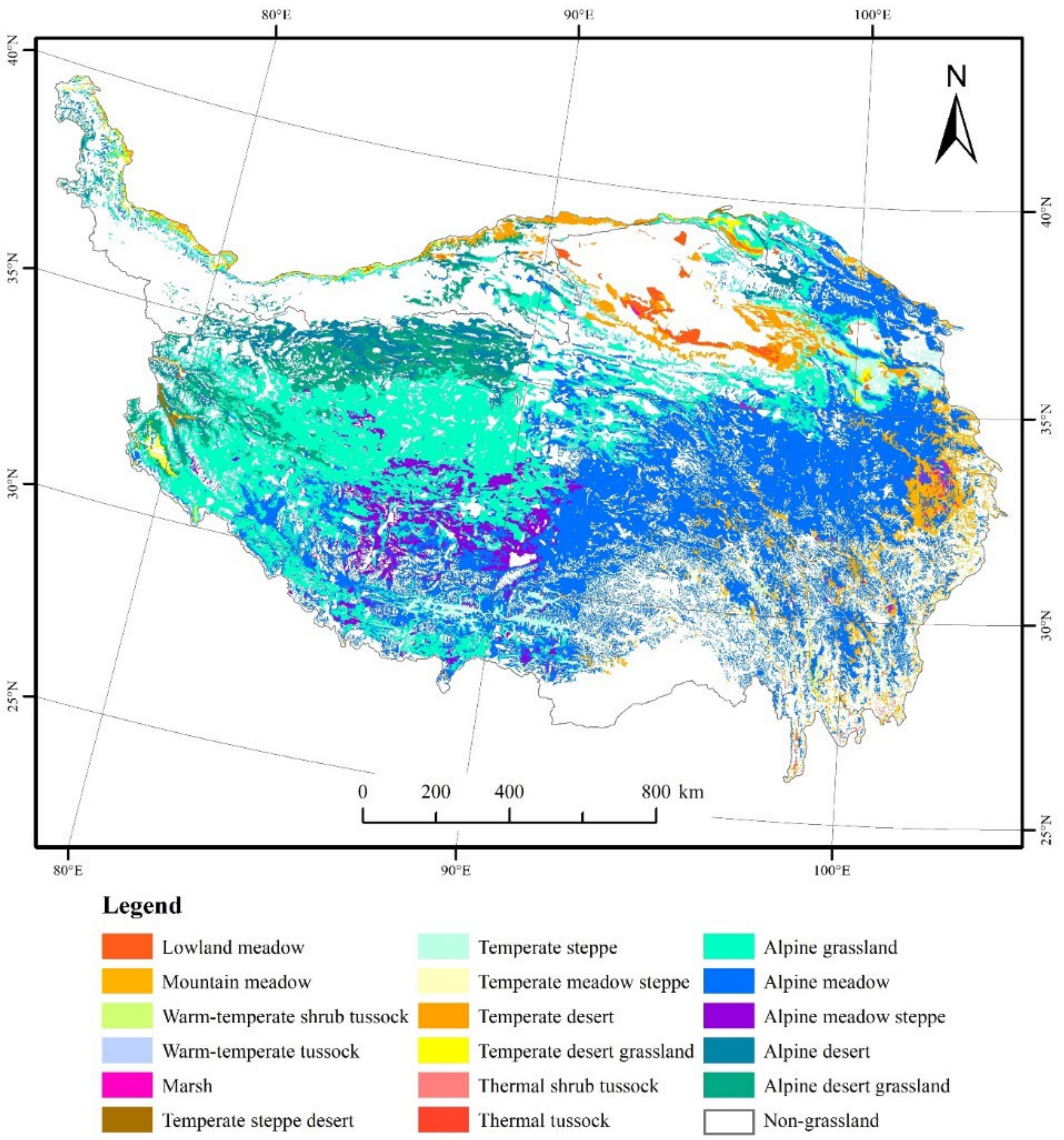


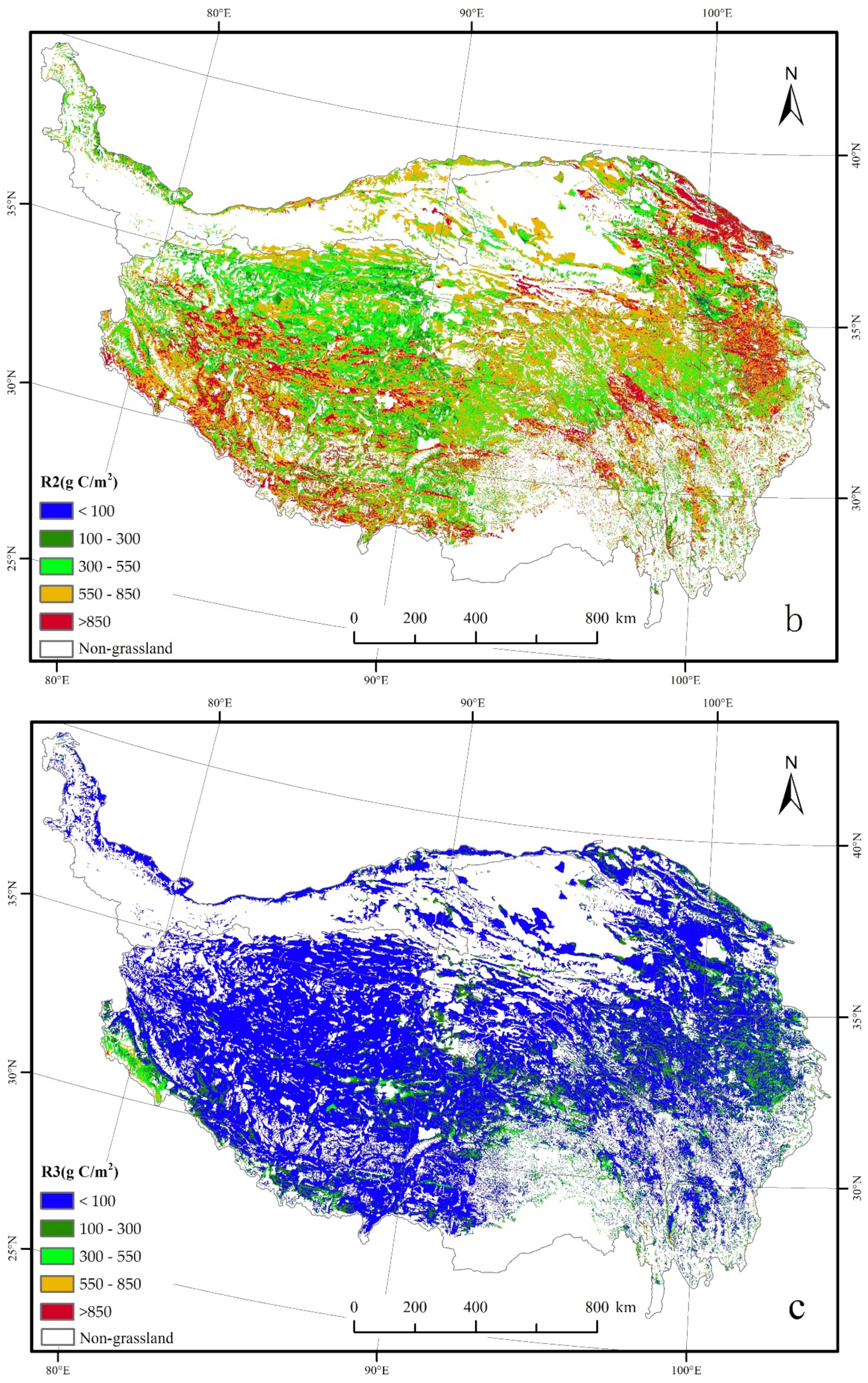



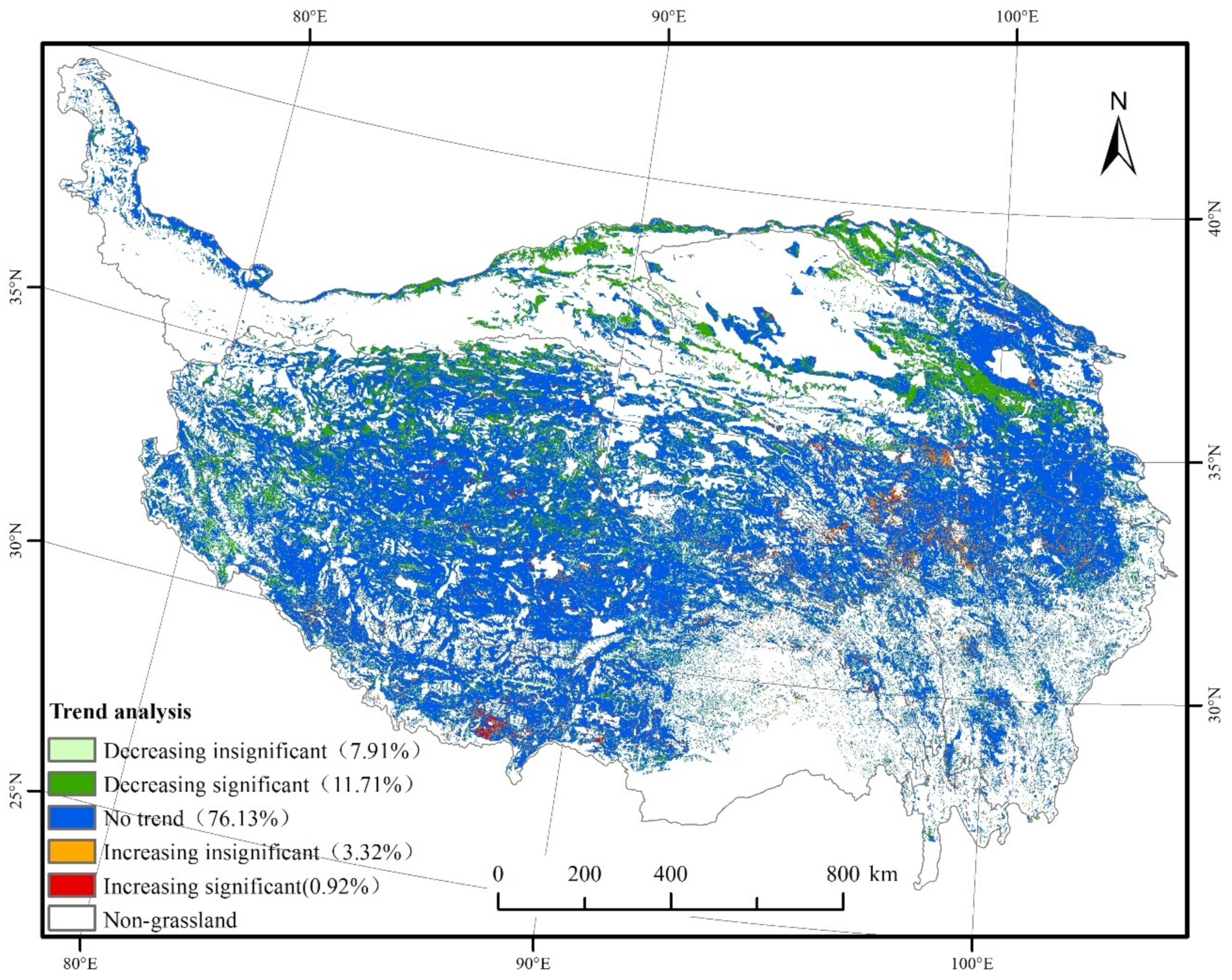


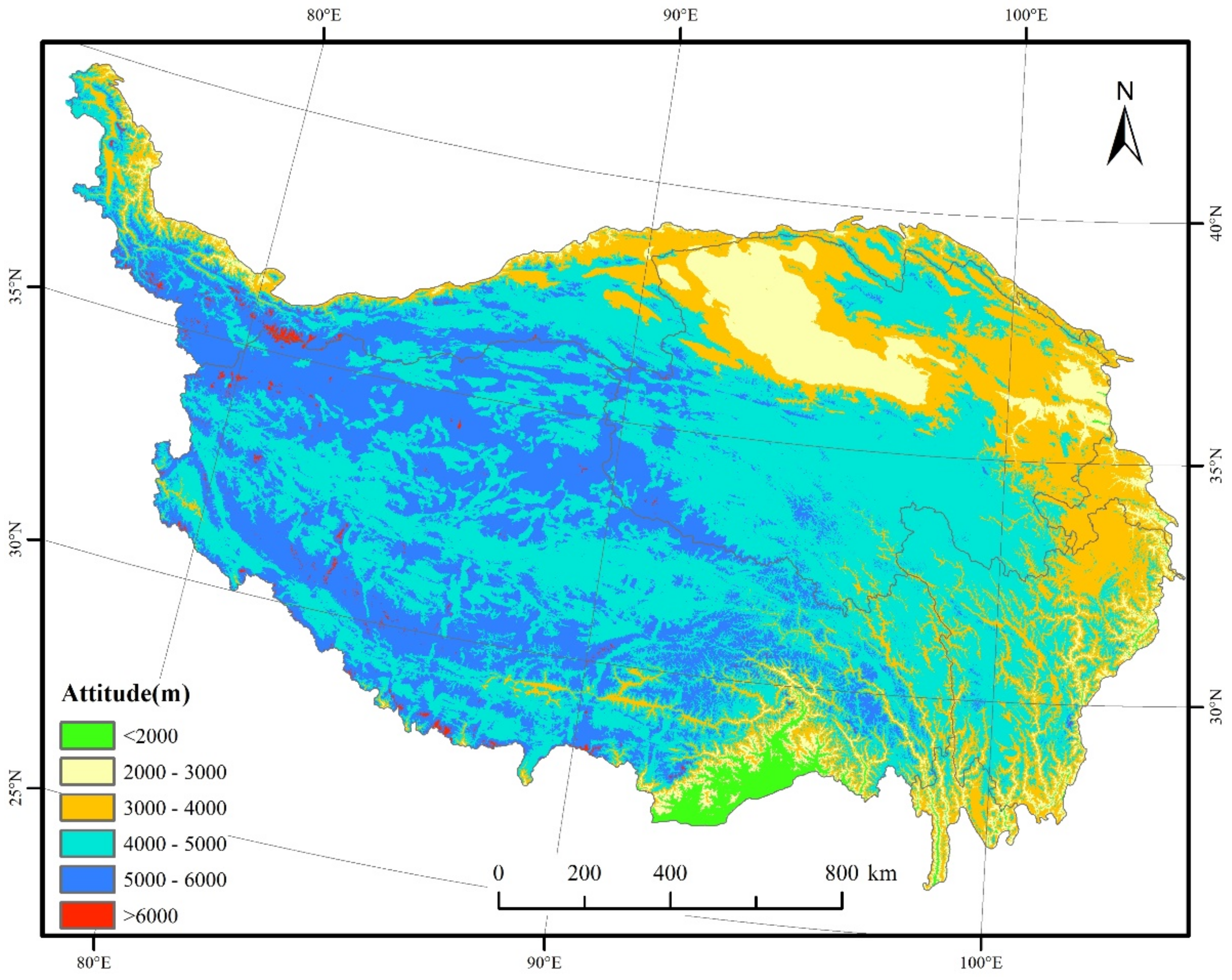


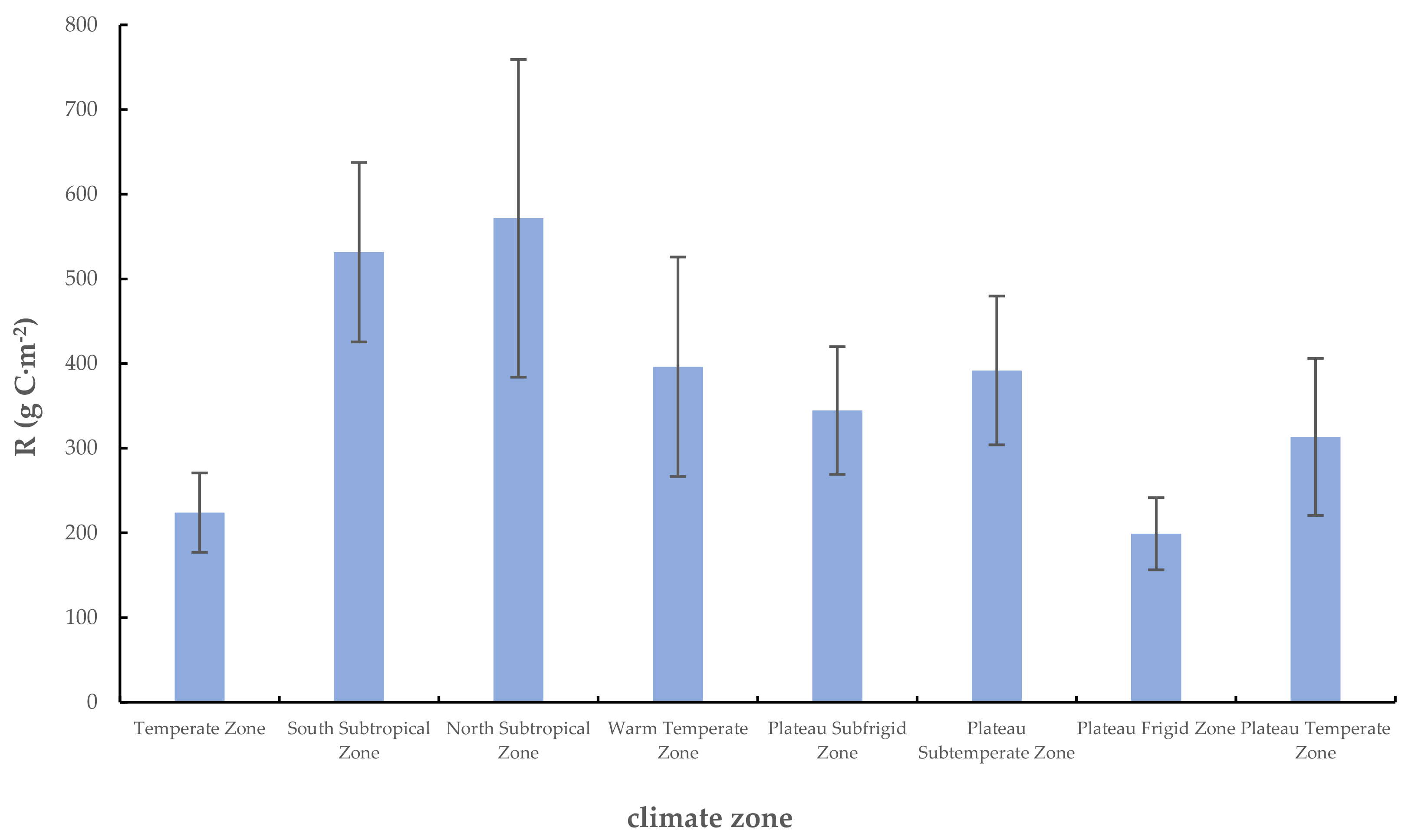
Publisher’s Note: MDPI stays neutral with regard to jurisdictional claims in published maps and institutional affiliations. |
© 2021 by the authors. Licensee MDPI, Basel, Switzerland. This article is an open access article distributed under the terms and conditions of the Creative Commons Attribution (CC BY) license (https://creativecommons.org/licenses/by/4.0/).
Share and Cite
Wang, R.; Feng, Q.; Jin, Z.; Liang, T. The Restoration Potential of the Grasslands on the Tibetan Plateau. Remote Sens. 2022, 14, 80. https://doi.org/10.3390/rs14010080
Wang R, Feng Q, Jin Z, Liang T. The Restoration Potential of the Grasslands on the Tibetan Plateau. Remote Sensing. 2022; 14(1):80. https://doi.org/10.3390/rs14010080
Chicago/Turabian StyleWang, Ruijing, Qisheng Feng, Zheren Jin, and Tiangang Liang. 2022. "The Restoration Potential of the Grasslands on the Tibetan Plateau" Remote Sensing 14, no. 1: 80. https://doi.org/10.3390/rs14010080




